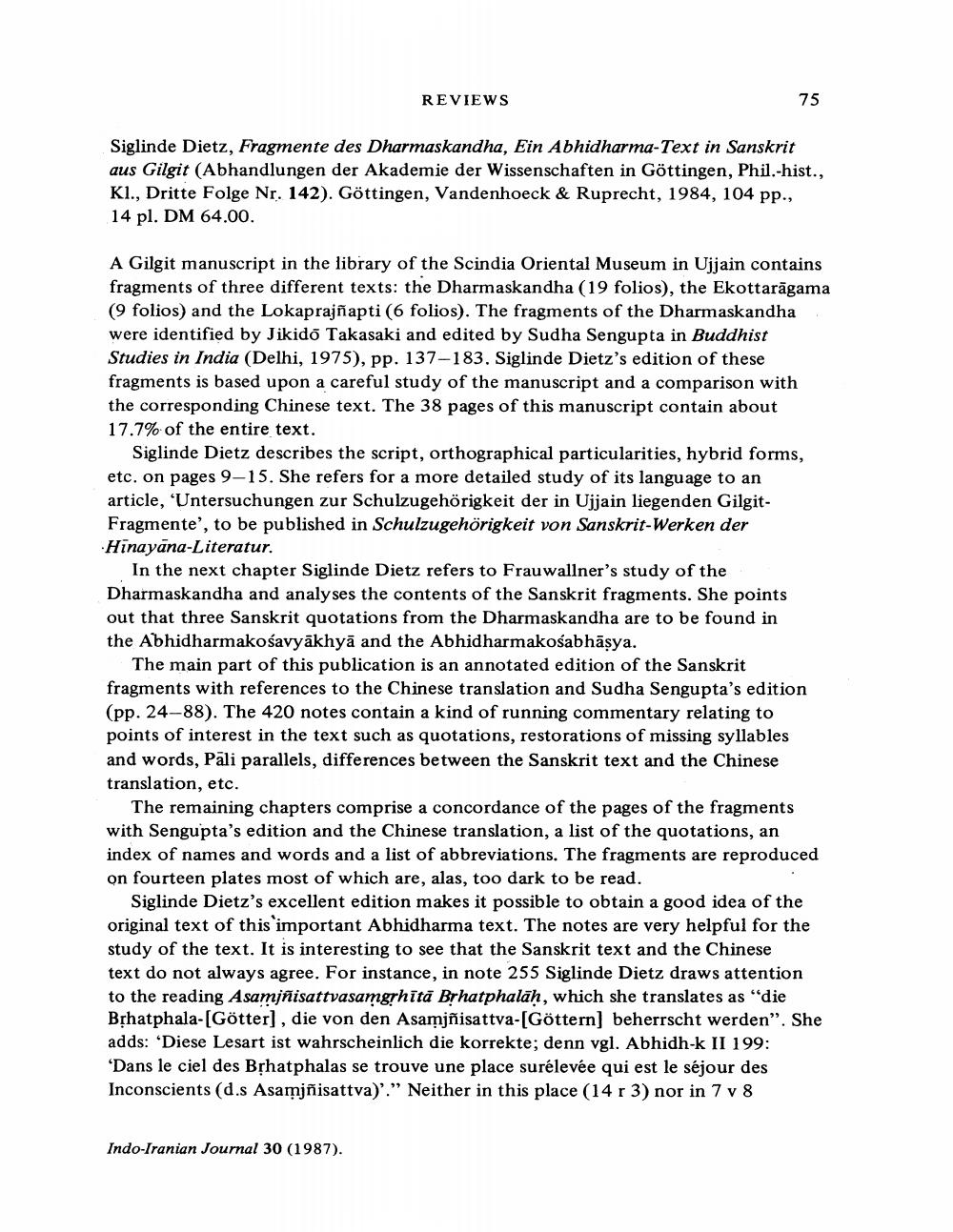________________
REVIEWS
75
Siglinde Dietz, Fragmente des Dharmaskandha, Ein Abhidharma-Text in Sanskrit aus Gilgit (Abhandlungen der Akademie der Wissenschaften in Göttingen, Phil.-hist., Kl., Dritte Folge Nr. 142). Göttingen, Vandenhoeck & Ruprecht, 1984, 104 pp., 14 pl. DM 64.00.
A Gilgit manuscript in the library of the Scindia Oriental Museum in Ujjain contains fragments of three different texts: the Dharmaskandha (19 folios), the Ekottarāgama (9 folios) and the Lokaprajñapti (6 folios). The fragments of the Dharmaskandha were identified by Jikido Takasaki and edited by Sudha Sengupta in Buddhist Studies in India (Delhi, 1975), pp. 137–183. Siglinde Dietz's edition of these fragments is based upon a careful study of the manuscript and a comparison with the corresponding Chinese text. The 38 pages of this manuscript contain about 17.7% of the entire text.
Siglinde Dietz describes the script, orthographical particularities, hybrid forms, etc. on pages 9-15. She refers for a more detailed study of its language to an article, 'Untersuchungen zur Schulzugehörigkeit der in Ujjain liegenden GilgitFragmente', to be published in Schulzugehörigkeit von Sanskrit Werken der Hinayāna-Literatur.
In the next chapter Siglinde Dietz refers to Frauwallner's study of the Dharmaskandha and analyses the contents of the Sanskrit fragments. She points out that three Sanskrit quotations from the Dharmaskandha are to be found in the Abhidharmakośavyākhyā and the Abhidharmakośabhāsya.
The main part of this publication is an annotated edition of the Sanskrit fragments with references to the Chinese translation and Sudha Sengupta's edition (pp. 24-88). The 420 notes contain a kind of running commentary relating to points of interest in the text such as quotations, restorations of missing syllables and words, Pali parallels, differences between the Sanskrit text and the Chinese translation, etc.
The remaining chapters comprise a concordance of the pages of the fragments with Sengupta's edition and the Chinese translation, a list of the quotations, an index of names and words and a list of abbreviations. The fragments are reproduced on fourteen plates most of which are, alas, too dark to be read.
Siglinde Dietz's excellent edition makes it possible to obtain a good idea of the original text of this important Abhidharma text. The notes are very helpful for the study of the text. It is interesting to see that the Sanskrit text and the Chinese text do not always agree. For instance, in note 255 Siglinde Dietz draws attention to the reading Asamjnisattvasamgrhītā Brhatphalāḥ, which she translates as "die Bịhatphala (Götter], die von den Asamjñisattva-(Göttern) beherrscht werden". She adds: 'Diese Lesart ist wahrscheinlich die korrekte; denn vgl. Abhidh-k II 199: ‘Dans le ciel des Bphatphalas se trouve une place surélevée qui est le séjour des Inconscients (d.s Asamjñisattva)'." Neither in this place (14 r 3) nor in 7 v 8
Indo-Iranian Journal 30 (1987).




